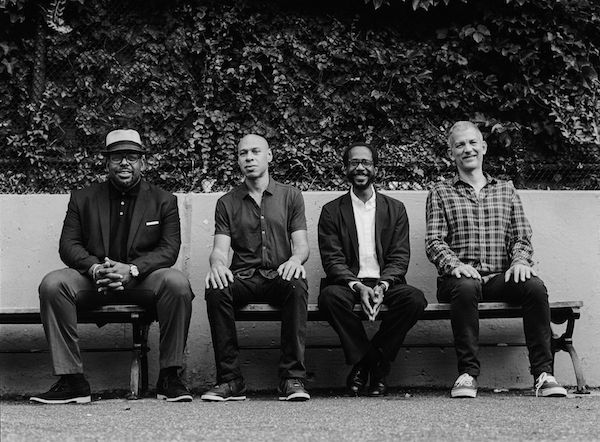Dec 9, 2025 12:28 PM
In Memoriam: Gordon Goodwin, 1954–2025
Gordon Goodwin, an award-winning saxophonist, pianist, bandleader, composer and arranger, died Dec. 8 in Los Angeles.…

Bassist Christian McBride (left), saxophonist Joshua Redman, drummer Brian Blade and pianist Brad Mehldau reconvened in the studio after more than two decades for RoundAgain.
(Photo: Michael Wilson)COVID-19 brought the entire world to a halt, but it’s not hyperbole to say jazz players have been uniquely affected by the situation we’re all living in now.
“I feel like I’ve been waiting 25 years for this,” said Redman, sequestered at his Berkeley home while speaking over FaceTime.
He’s disappointed about the scrapped tour and finds it difficult to not play music with friends, in general.
“The social-distancing thing, that’s not hard for me; I’m an antisocial motherfucker,” Redman said, laughing. “I mean, I’m not antisocial, but by nature I’m an introvert. Music is my social life—having that opportunity for real connection and communion with other human beings. ... [F]or me, music is that as much as it is anything.”
The connection and communion Redman spoke of was evident in the quartet from the start, according to Blade: “I do recall there was a great kinship and a sort of unspoken understanding of how to give the music—and each other and the wholeness of the group—what it needed for the music to continue to rise and lift people’s spirits, and simultaneously ours as well.”
Underscoring the sublime performances on MoodSwing was a level of expressiveness and openness to musical possibilities that would cross the jazz Rubicon, foreshadowing the universal acceptance of each player by their peers and the general public. The way they played together was in stark contrast to the music that jazz critics—according to Redman’s liner notes from the 1994 disc—would denigrate as “an elite art form, reserved for a select group of sophisticated (and rather eccentric) intelligentsia.”
Today, Redman is quick to point out that he wasn’t implying that jazz actually had become as haughty as some had suggested, and the music on MoodSwing speaks eloquently to that very point. But had the four of them back then discussed how they wanted their music to sound or how their album could be seen as a kind of pushback against those writers?
“I’m saying that not only were we not having long discussions,” said Redman, incredulously, “we have never had any discussion. I can definitely say that we have never, ever, the four of us, said one word about that. We don’t give a shit about that. We care about making music together. And if we’re true to that, then the rest, I hope, will take care of itself.”
Unspoken as it was, the body of work Redman, Blade, Mehldau and McBride have each amassed since that time seems to adhere to a precept combining their formidable musical acumen with an ability to play to the emotional heart of the matter, resulting in a resonance beyond boundaries. And their individual careers have taken each outside the genre: Redman’s forays into electronic funk; Mehldau with his solo and trio treatments of The Beatles, Radiohead and Soundgarden; McBride in his work with Sting, D’Angelo and Kathleen Battle; and Blade sitting behind the drums for artists like Joni Mitchell, Bob Dylan and Seal.
Blade sees the quartet’s multifaceted experiences as part of their collective identity in jazz, something one can hear on RoundAgain. “One thing does not negate another, especially in the music. When we make records, we want to make something enduring, regardless of what it might be labeled,” he said.
It’s a revelation to hear these same four incandescent minds, now filtered through a quarter-century of experience and wisdom, sounding like the band they once were, yet different—somehow even better. Listening to the new album and the group’s first effort back-to-back is like getting into a DeLorean time machine; things are at once eerily familiar and refreshingly new.

Goodwin was one of the most acclaimed, successful and influential jazz musicians of his generation.
Dec 9, 2025 12:28 PM
Gordon Goodwin, an award-winning saxophonist, pianist, bandleader, composer and arranger, died Dec. 8 in Los Angeles.…

Nov 13, 2025 10:00 AM
For results of DownBeat’s 90th Annual Readers Poll, complete with feature articles from our December 2025 issue,…

Flea has returned to his first instrument — the trumpet — and assembled a dream band of jazz musicians to record a new album.
Dec 2, 2025 2:01 AM
After a nearly five-decade career as one of his generation’s defining rock bassists, Flea has returned to his first…

To see the complete list of nominations for the 2026 Grammy Awards, go to grammy.com.
Nov 11, 2025 12:35 PM
The nominations for the 2026 Grammy Awards are in, with plenty to smile about for the worlds of jazz, blues and beyond.…

Drummond was cherished by generations of mainstream jazz listeners and bandleaders for his authoritative tonal presence, a defining quality of his style most apparent when he played his instrument unamplified.
Nov 4, 2025 11:39 AM
Ray Drummond, a first-call bassist who appeared on hundreds of albums as a sideman for some of the top names in jazz…